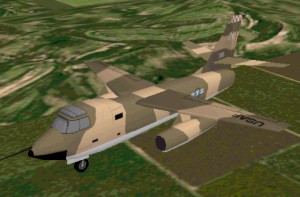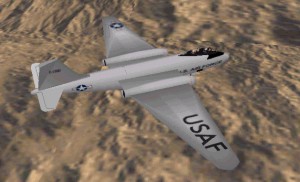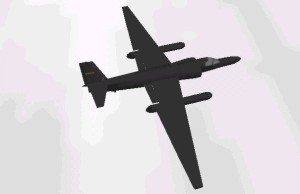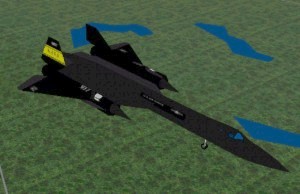[ Home
| Recce | Photo
Recon | FAC | AWACS
| MP
| ONAC Home
|
Links ]
RECCE
Miscellanious Reconnaissance Aircraft
This is the section of the dunno-where-they-belong-to-planes.
Here you got planes from the almost hovering Mohawk to the lightning-fast
Blackbird, the fastest aircraft only second to the X-15 (which wasn't an
aircraft but a rocket, by the way).
 Grumman OV-1A Mohawk
Grumman OV-1A Mohawk
Name: mohawkmh.zip
Author: Mike Hill
Version: FS5
Size: 76 kB
Remark:
History: Grumman undertook development of the Mohawk in an unusual
joint program sponsored by the U.S. Army and Marine Corps. The two services
shared broadly similar requirements for an observation aircraft with Short
Takeoff and Landing (STOL) performance and the ability to operate under
spartan conditions along-side frontline troops. Grumman and Lycoming were
the unanimous choice of a joint service selection board for airframe and
engine manufacturers, and the aircraft was designated OF-1 in Marine markings
and AO-1 with the Army. Soon after the detailed wooden mockup was displayed,
the Marines withdrew from the Mohawk program for economy reasons, but in
April 1958, the Army gave Grumman the go-ahead for nine YAO-1 prototypes.
The joint service roots of the Mohawk did, however, result in the aircraft
being evaluated by the U.S. Navy, and all early contracts were placed through
the Navy on the behalf of the Army. Fast, quiet, and rugged, the 'Hawks
in Vietnam proved their worth time and again. At the full-scale battle
of laDrang in 1965, and later in the Bong Son campaign, the few Mohawks
available provided the ground forces with important visual reconnaissance
reports. The Air Force used precision targeting data from OV-1s to direct
B-52 strikes. Navy coastal patrol forces were directed to infiltration
points discovered by Mohawk radar; and the Marines made good use of Mohawk
night recon data in the conduct of Operation Starlight in August 1965.
Regardless of official policy, OV-1s in Southeast Asia often flew armed
with a mix of rocket and gun pods. The rugged constitution of the aircraft
proved a blessing for flightcrews, particularly when Viet Cong forces were
equipped with heavier weapons and learned how to use them against low-flying
aircraft. Still today Grumman continues to update Mohawks at the company's
Stuart, Florida facility. And with new avionics and nap-of-the-earth flying
tactics, Grumman's bug-eyed, multi-sensor bird is expected to serve with
the Army well into the nineties.Overshadowed by sleek spyplanes and all-seeing
satellites, the OV-1 remains a potent, responsive reconnaissance platform
-- one that will stay in the frontlines of aerial intelligence gathering
for some time to come.
 Douglas RB-66B Destroyer
Douglas RB-66B Destroyer
Name: rb66-98.zip
Author: Jerry "Zeke" Arzdorf
Version: FS98
Size: 62 kB
Remark: Panel included
History: The B-66 was the USAF version of the USN's A-3, a much-modified
aircraft. One change for the worse was the replacement of the J57 engine
by the less satisfactory J71. The USAF used only 72 of its 294 B-66's as
bombers, because fighter-bombers were more effective and less vulnerable.
Most B-66s became electronic warfare and ELINT platforms. There were also
some WB-66 wheater aircraft. They often escorted attack or bomber units
during the Vietnam war. 294 RB-66 were built. This plane is at the
Pima Air Museum in Tucson, AZ
 Martin RB-57D Canberra
Martin RB-57D Canberra
Name: rb-57d.zip
Author: Jerry "Zeke" Arzdorf
Version: FS5
Size: 85 kB
Remark: AFX and PCX files included
History: In the late 40s the Glenn L. Martin Company was approached
with the proposal that it build the English Electric Canberra B Mk1 under
license designated as B-57. The RB-57A (Martin Model 272A) was a reconnaissance
version of the B-57A bomber. The decision to develop a reconnaissance version
of the B-57A was made in October of 1951, guided by experience in the Korean
War, which had underscored USAF reconnaissance shortcomings in the face
of increasingly effective enemy air defenses. Cameras installed aft of
the bomb bay constituted the main difference between the RB-57A and the
B-57A. The intended mission included day and night, high and low, and visual
and photographic reconnaissance. Unlike the B-57A, the RB-57A was totally
unarmed. It was painted with a high gloss black paint which was intended
to minimize detection by searchlights. The crew was two -- one pilot and
one photo-navigator. It was intended that only a minimum of effort would
be required to convert the RB-57A to a bomber mission -- which was never
actually done in practice. In the late 1950s, the Federal Aviation Administration
(FAA) acquired two RB-57As for use in evaluation of high-altitude airways
in preparation for the introduction of jet-powered commercial transports
 Lockheed U-2R
Lockheed U-2R
Name: u2_10.zip
Author: Washington F. de A. Kuhlmann Jr.(no
email known)
Version: FS5
Size: 79 kB
Remark:
History: The U-2, a high-flying reconaissance aircraft, was camouflaged
by this inoccent 'utility' designation. Ironically, it has become the most
famous U-designated aircraft... The extremely high-flying U-2 spyplane
became infamous in 1960 by being shot down over the Soviet Union. After
that, the U-2 was claimed to be restricted to meteorological and environment
control flights, but it continued to spy above countries other than the
USSR, such as China and Cuba. Some were shot down. The WU-2 was used for
sampling of the stratosphere, and examining the fall-out from nuclear tests.
Later versions had a J75 engine. The U-2R is a much-modified version with
two large pods on the wing, built in the second and third production runs
--- the aircraft of the third series were named TR-1 for some time. The
latest U-2R models were still present during the 1991 Gulf War. Reengining
with the lighter and more powerful G.E. F118-GE-F29 engine is under way.
 Lockheed SR-71A Blackbird
Lockheed SR-71A Blackbird
Name: sr71.zip
Author: Mike Hill
Version: FS5
Size: 57 kB
Remark: AFX file included
History: The SR-71 is a famous Mach 3+ spy plane. This is the fastest
aircraft ever known to be in service with an air force. The large, delta-winged
SR-71 gets is performance from the unusual J-58 engines, that act at as
ramjets at high altitude and speed. It was related to the the YF-12 fighter
and its precessor, the A-12 CIA-operated spy aircraft. Recently, the a
number of SR-71s was put back in service from a premature retirement.
This aircraft is depicted as a USAF SR-71A operated by NASA on long
range surveillance/reconnaisance.
 HOME
HOME
[ Home
| Recce | Photo
Recon | FAC | AWACS
| MP
| ONAC Home
|
Links ]
 Grumman OV-1A Mohawk
Grumman OV-1A Mohawk
 Douglas RB-66B Destroyer
Douglas RB-66B Destroyer
 Martin RB-57D Canberra
Martin RB-57D Canberra
 Lockheed U-2R
Lockheed U-2R
 Lockheed SR-71A Blackbird
Lockheed SR-71A Blackbird